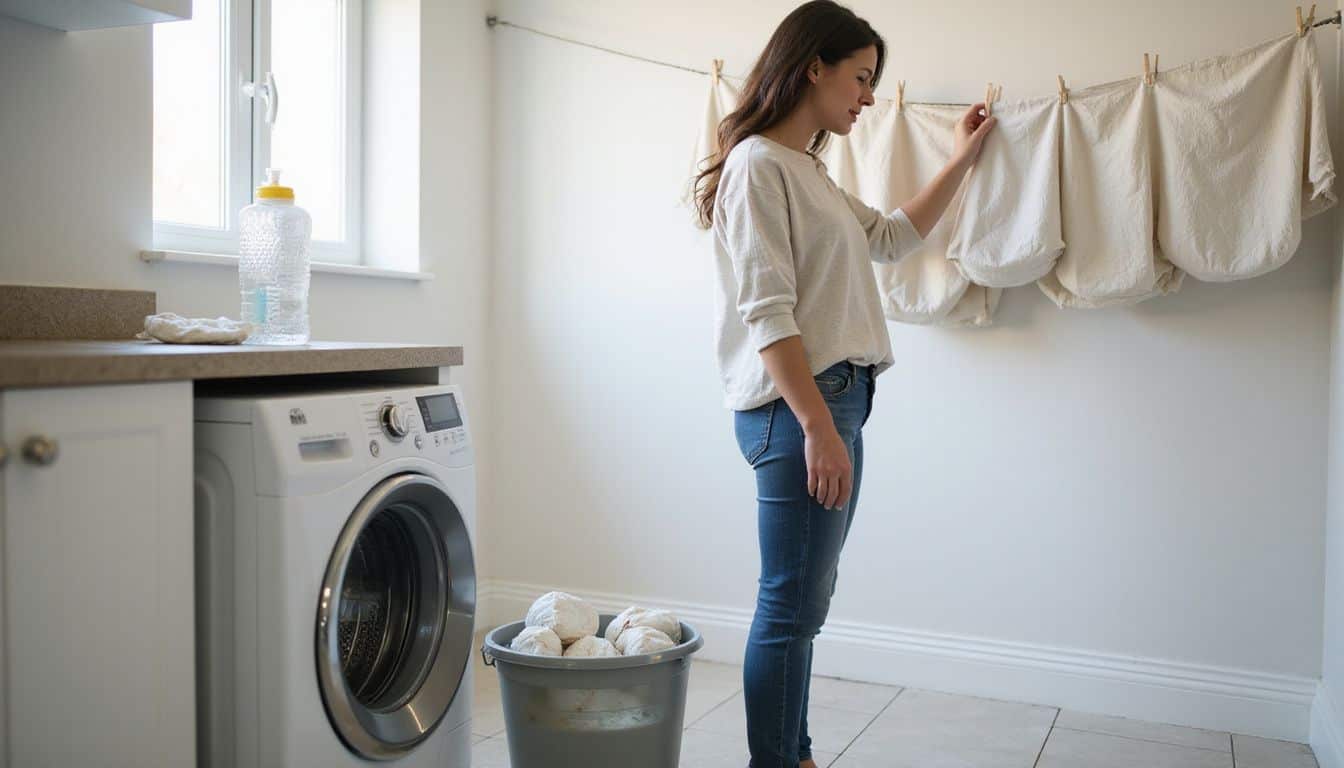Struggling with how to clean cloth diapers without causing rashes or dealing with stubborn stains? Many parents find that washing cloth diapers can actually be enjoyable since everything gets done in one simple load.
This complete guide will walk you through proper washing techniques, stain removal tricks, and maintenance tips that work with your washing machine and water conditions. Get ready to master diaper care like a pro.
Key Takeaways
New cloth diapers require 4-8 hot wash cycles to remove natural oils and achieve maximum absorbency before first use.
Store dirty diapers using dry pail method with tight-fitting lids, washing every 2-3 days to prevent odor buildup.
Breastfed baby waste dissolves completely in washing machines, while formula-fed babies require solid waste removal before washing.
Use hot water (140-160°F) for main wash cycles after cold rinse to kill germs and remove stubborn stains effectively.
Sunlight naturally bleaches diaper stains, while lemon juice mixed with water provides safe, chemical-free stain removal treatment.
Table of Contents
Preparing Cloth Diapers for First Use

New cloth diapers need special care before they work their best, and this prep work makes all the difference for your baby’s comfort. Fresh diapers straight from the package won’t absorb properly until you wash them several times… so let’s get them ready for action.
How do I wash new cloth diapers before using them?
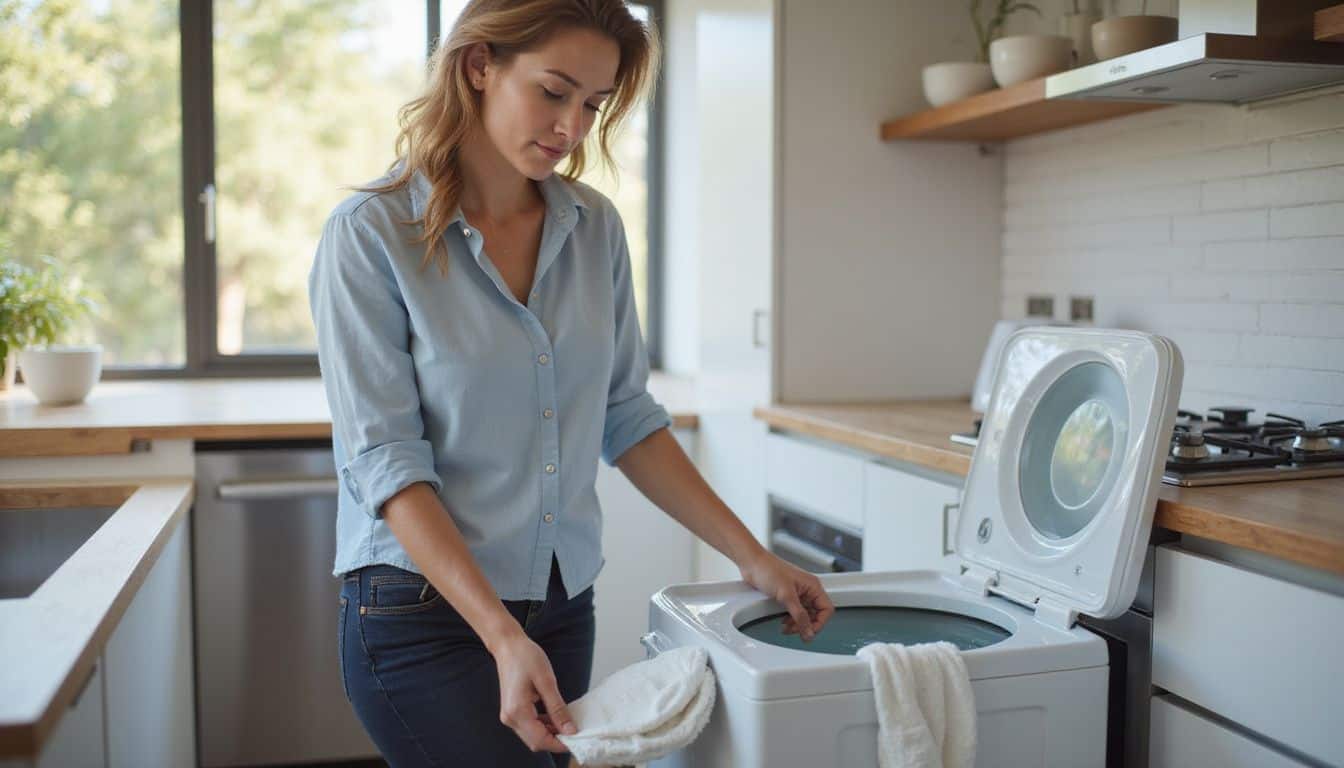
New cloth diapers need proper washing before first use to reach their full absorbency potential. Natural fiber diapers contain plant oils that must be removed through multiple wash cycles.
- Start with a heavy-duty wash cycle using 1-2 scoops of washing powder as soon as you receive your new diapers from the package.
- Run 4-8 hot, heavy-duty wash cycles to achieve maximum absorbency, especially for natural fiber materials like organic cotton prefolds.
- Use two washing cycles for each wash day: begin with a normal cycle using warm water, then follow with a heavy-duty cycle using hot water.
- Check if your brand pre-washes their materials, since companies like Esembly pre-wash their organic cotton five times to remove 90% of cotton oils.
- Skip fabric softeners and dryer sheets during the prep washing process, as these products can coat fibers and reduce absorption capacity.
- Test absorbency after each wash cycle by dropping water on the diaper surface to see if it soaks in quickly.
- Consider your water type when choosing detergent, since hard water may require a water softener or different laundry detergent for best results.
- Buy newborn cloth diapers in Canada from trusted retailers who provide clear washing instructions with their products.
- Dry your freshly washed diapers completely between prep cycles, using either line drying or your dryer on appropriate heat settings.
How should I pre-treat natural fiber cloth diapers?
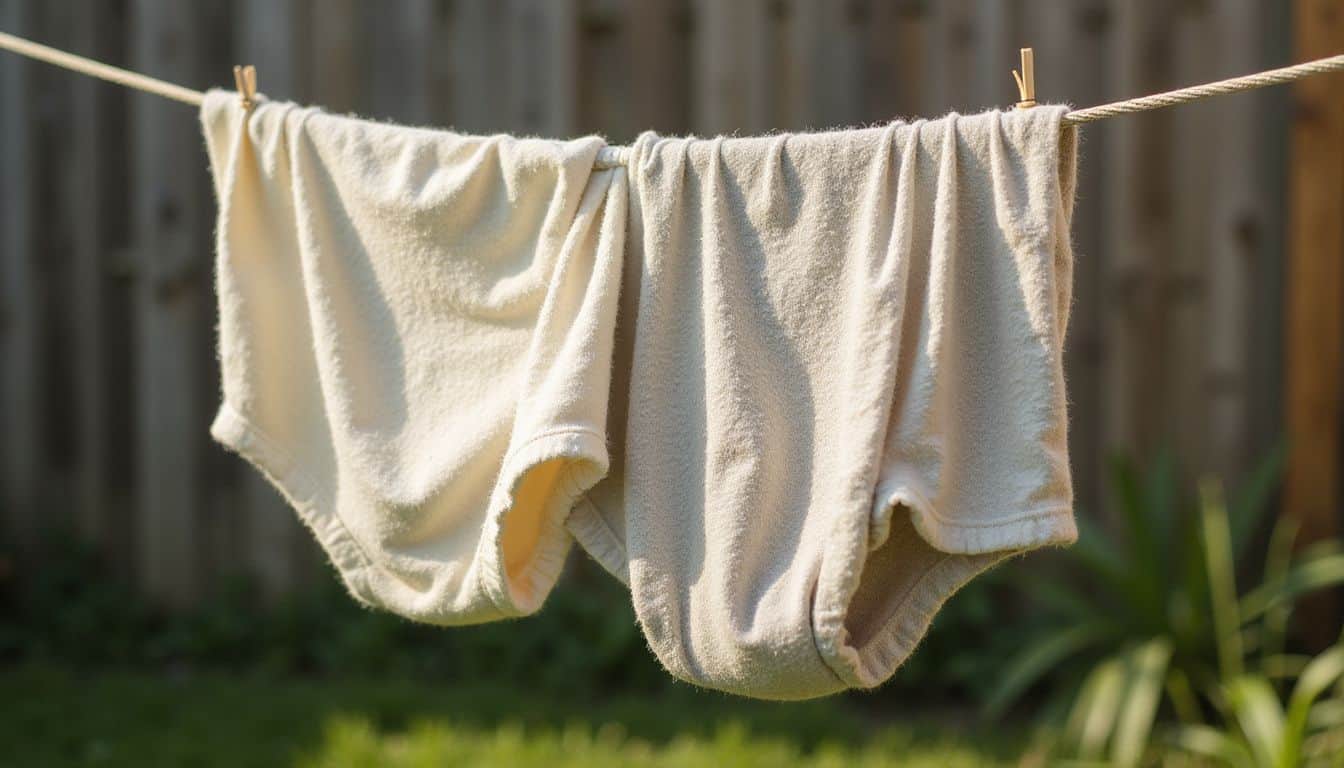
Natural fiber cloth diapers need special care before their first use to work properly. These diapers contain natural oils that block water absorption, so pre-treatment removes these barriers.
- Wash organic cotton, bamboo, and hemp diapers three times back-to-back using your regular detergent to strip away natural oils that prevent proper absorption.
- Use hot water during all three wash cycles to break down oils more effectively than cold water can manage.
- Run a full spin cycle after each wash to remove excess water and oils from the fabric fibers completely.
- Skip fabric softeners during pre-treatment since they coat fibers and reduce the diaper’s ability to absorb moisture.
- Line dry your natural fiber diapers after each pre-treatment wash to maintain fabric quality and prevent shrinkage from high dryer heat.
- Check absorbency after the third wash by pouring water on the diaper, which should soak in quickly rather than beading up on the surface.
- Repeat the washing process if water still beads on the fabric, as some natural fibers need extra cycles to reach full absorbency.
- Avoid chlorine bleach during pre-treatment since it weakens natural fibers and can cause permanent damage to your diaper investment.
How should I store dirty cloth diapers?
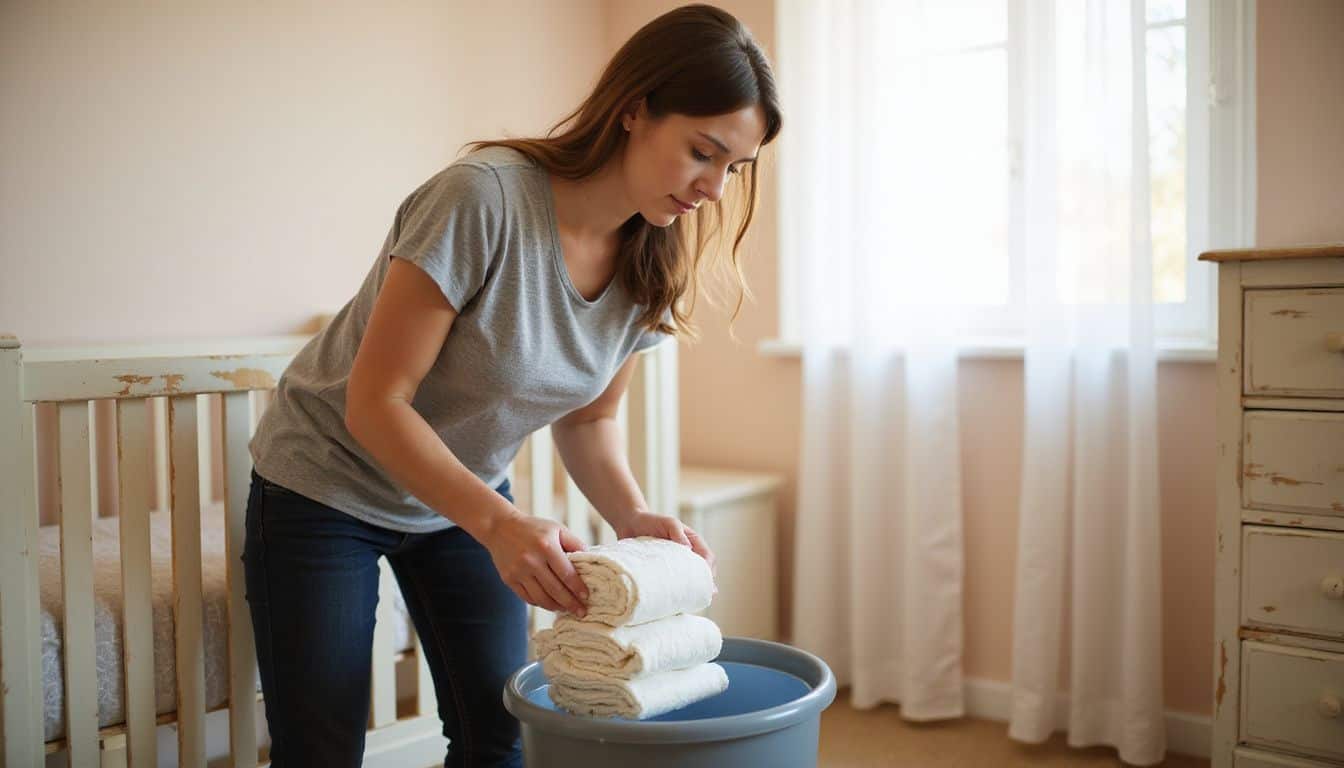
Storing dirty cloth diapers properly prevents odors and keeps your nursery fresh until washday arrives. You can choose between dry storage in a diaper pail with a pail liner or wet storage methods using a wet bag filled with water.
What are the best dry storage methods for dirty diapers?
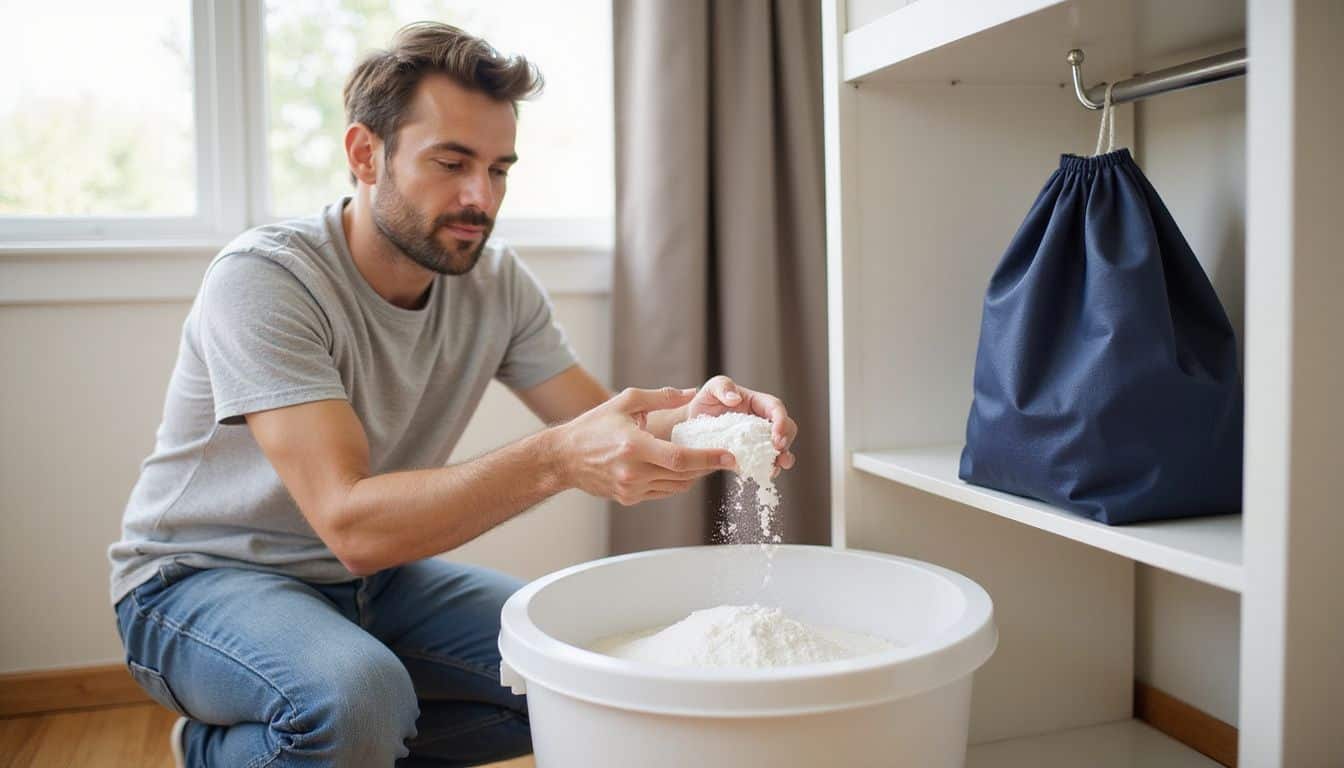
The Dry Pail Method works best for storing soiled cloth diapers without water. This approach prevents odors and keeps your laundry routine simple.
- Use a diaper pail with a tight-fitting lid to contain smells and keep dirty diapers contained until washday arrives.
- Line your diaper pail with a pail liner that you can wash with your diapers, making cleanup easier and more sanitary.
- Remove solid waste from diapers before placing them in the dry storage container to minimize odors and prevent staining.
- Choose a wet bag for smaller storage needs or travel situations where a full diaper pail isn’t practical.
- Place baking soda in the bottom of your diaper pail to absorb moisture and neutralize unpleasant smells naturally.
- Wash your stored diapers every 2-3 days to prevent odor buildup and maintain proper cloth diaper care standards.
- Keep your storage container in a well-ventilated area away from direct sunlight to prevent bacterial growth and fabric damage.
- Hang dry or wet bags to save space in your nursery while reducing the risk of spills during diaper changes.
How do wet storage methods work for cloth diapers?
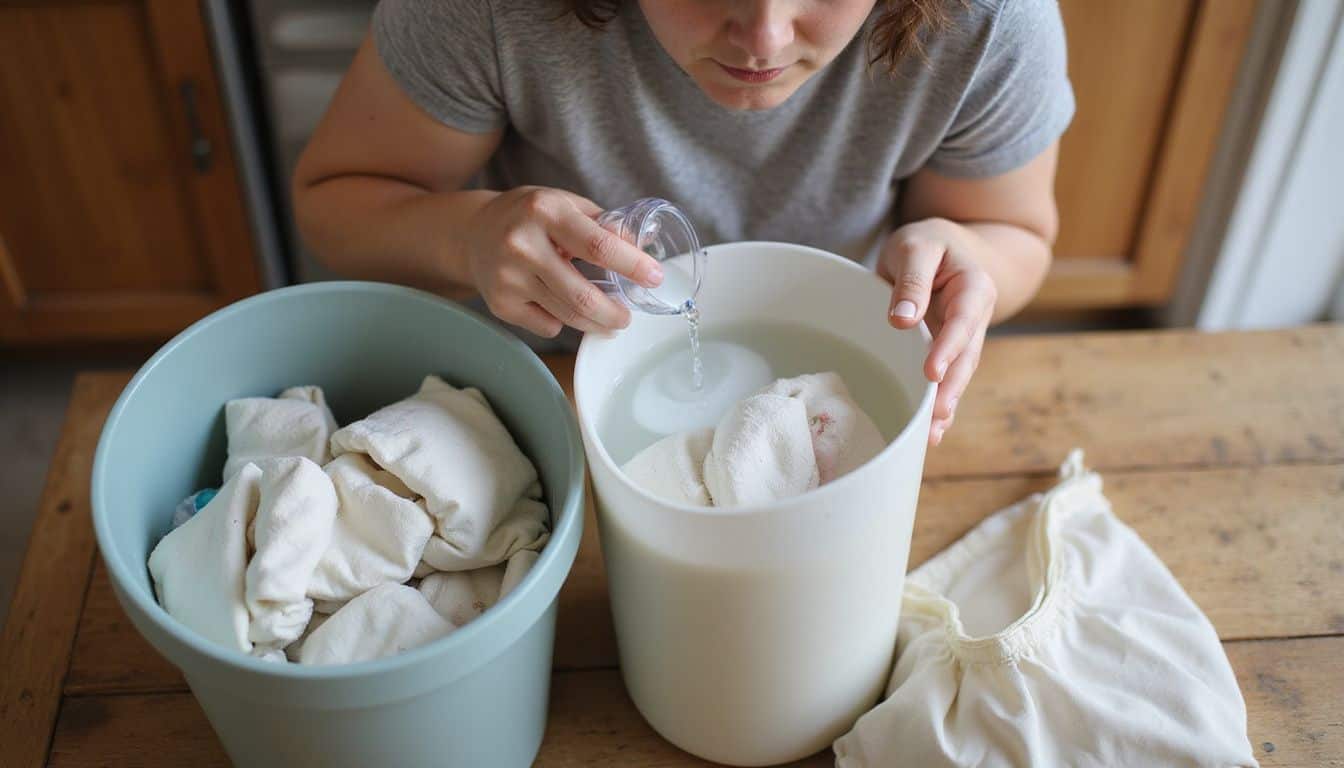
Wet storage methods use water to pre-soak dirty cloth diapers until wash day. This approach helps prevent stains from setting into diaper inserts and fabric.
- Fill a sealed pail with cold water and place soiled diapers inside to soak until you’re ready to wash them in your washing machines.
- Change the water in your wet pail daily to prevent strong odors and permanent staining on your cloth diapers and inserts.
- Add a small amount of detergent or oxygen bleach to the water to help break down waste and reduce bacteria growth.
- Keep the pail tightly covered at all times to prevent accidents and reduce smells throughout your home.
- Rinse diapers with breastmilk poop thoroughly before placing them in the wet storage container since breast milk waste dissolves easily.
- Combine wet and dry storage by rinsing dirty diaper inserts first, then storing them in a wet bag until wash day.
- Avoid using wet storage methods with modern cloth diapers due to safety hazards, especially around children and pets.
- Remove diapers from wet storage and run them through a rinse cycle before starting your main wash with regular detergents.
How do I remove poop from cloth diapers?

Dealing with poop on cloth diapers might seem gross at first, but it gets easier once you know the right tricks. Different types of baby waste need different cleaning methods, and having the right tools like a diaper sprayer can make this messy job much simpler.
How do I clean exclusively breastfed poop from diapers?
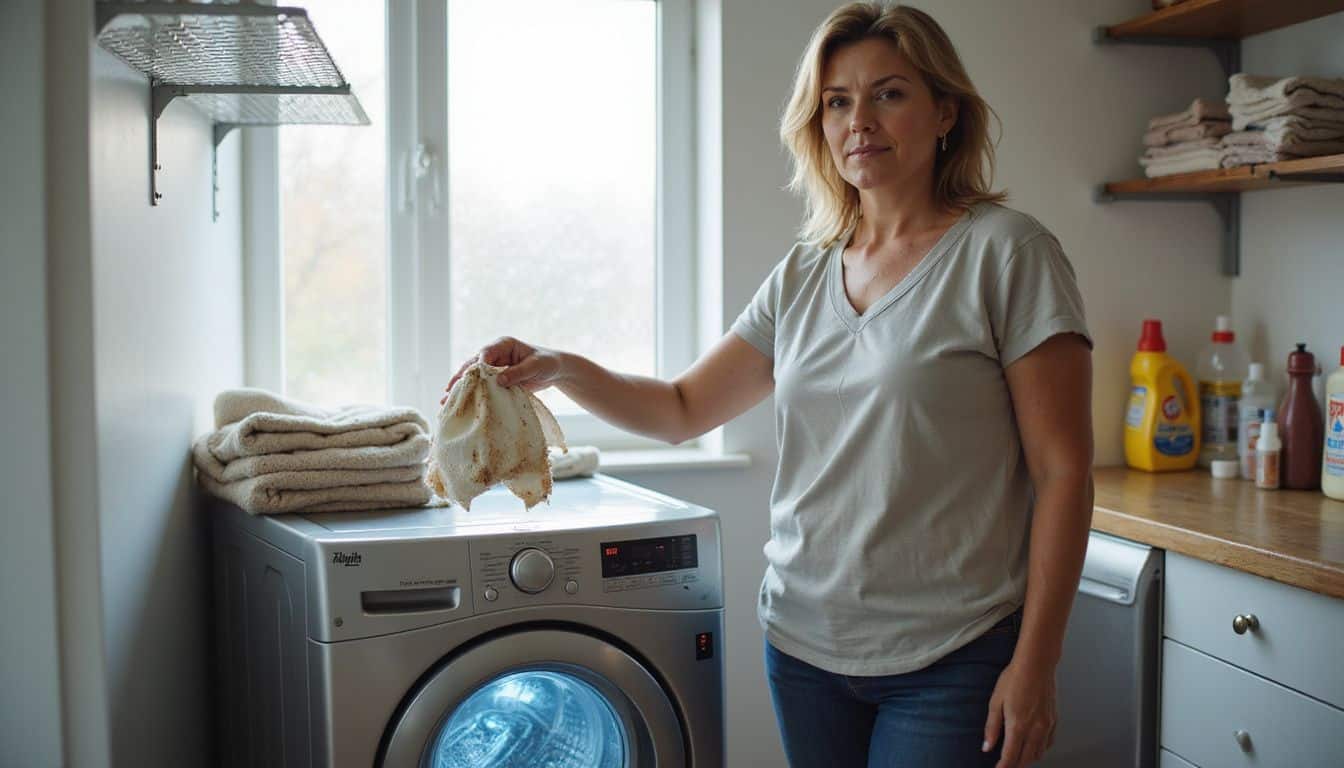
Breastfed baby poop dissolves completely in water during washing. Babies on a milk-only diet do not require poop removal or pre-rinsing before laundering cloth diapers.
- Skip the diaper sprayer entirely since water-soluble poop breaks down naturally in your washing machine without any pre-treatment steps.
- Place soiled diapers directly into your dry storage container or wet bag after changing your baby’s diaper.
- Toss dirty diapers straight into your laundry machine without scraping, spraying, or rinsing the poop off first.
- Run a cold rinse cycle to help dissolve the waste before starting your main wash with regular detergent.
- Use warm water for the main wash cycle to ensure thorough cleaning without damaging the diaper fabric.
- Check that no detergent residue remains after washing, as leftover cleaning products can cause diaper rash on sensitive skin.
- Air dry your clean diapers on a line or use your dryer on low heat to prevent damage to elastic components.
- Avoid using fabric softeners or scents in your washers, as these products reduce absorbency and may irritate baby’s skin.
How do I handle formula-fed or solid food poop?
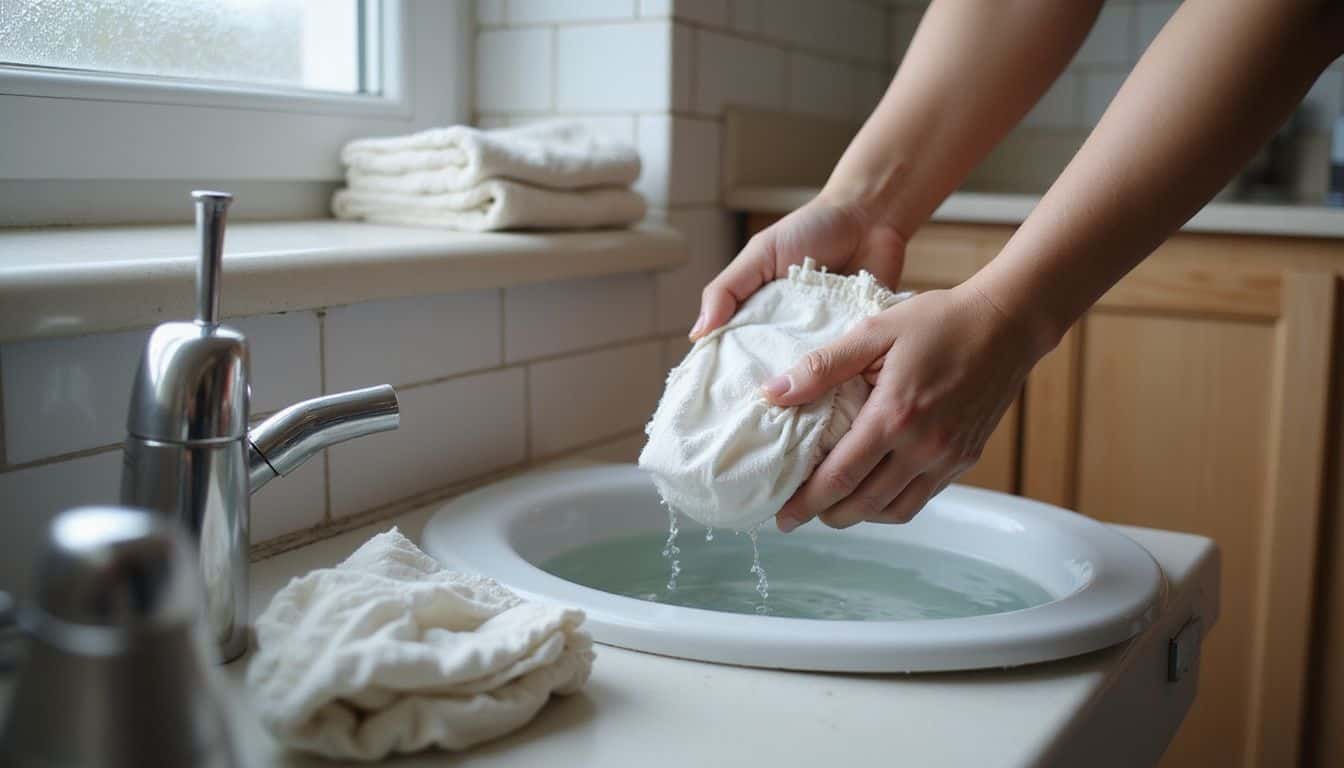
Formula-fed babies and those eating solid foods produce waste that requires different handling than breastfed babies. Solid waste from formula-fed or solids-eating babies must be disposed of in the toilet before washing the diaper.
- Shake the diaper over the toilet to remove loose solid waste pieces that fall off easily without much effort.
- Scrape stubborn poop off the diaper using a spatula or old spoon, then dispose of waste directly into the toilet bowl.
- Spray solid waste off using diaper sprayers attached to your toilet for easier cleanup and less mess on your hands.
- Dump larger solid pieces directly from the diaper into the toilet, making sure all visible waste goes down the drain.
- Use fleece liners inside cloth diapers to catch solid waste, making removal much simpler than cleaning the diaper itself.
- Rinse the diaper in cold water after removing solids to prevent stains from setting into the fabric fibers.
- Place disposable diaper liners in cloth diapers before use to create a barrier that catches most solid waste materials.
- Hold the diaper firmly while shaking or scraping to avoid dropping it or getting waste on bathroom surfaces around you.
When and how should I use diaper liners?
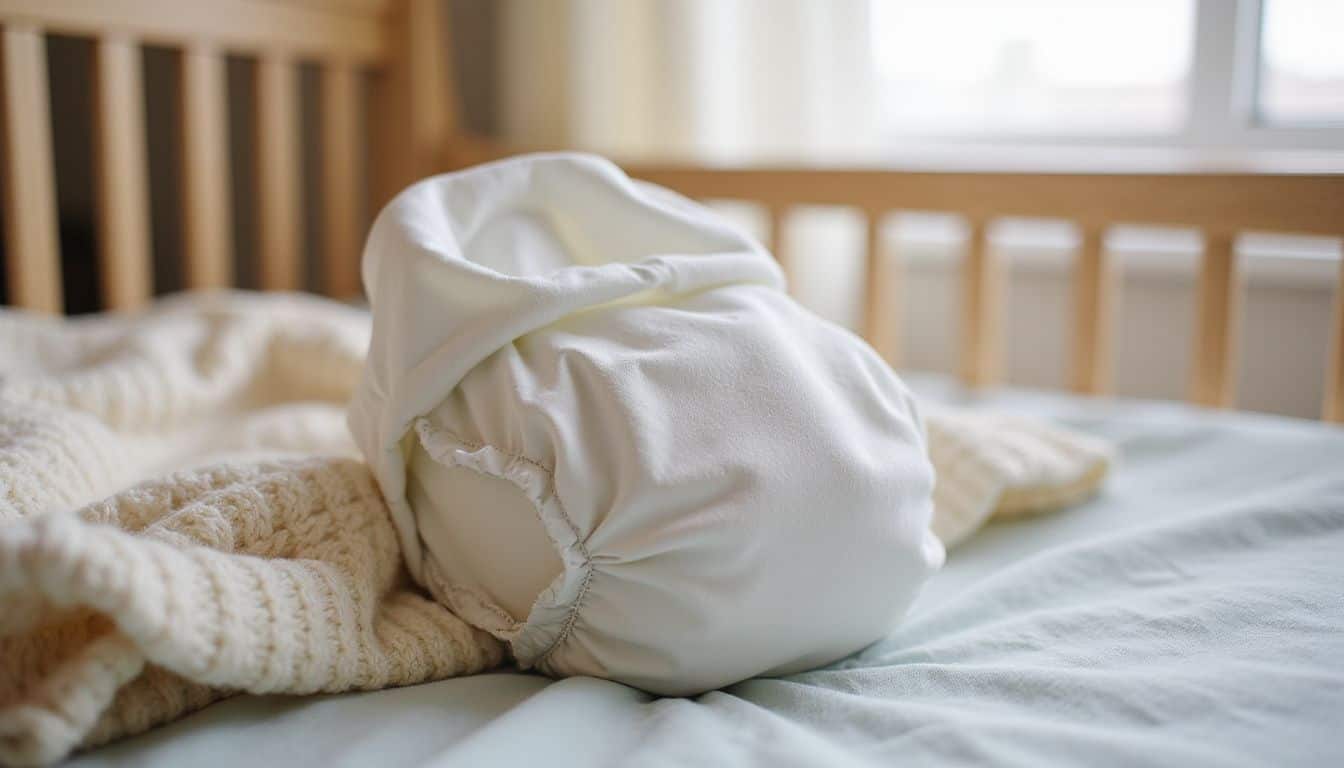
Solid food poop requires more work to remove, but diaper liners make this task much easier. These helpful accessories catch waste before it touches the diaper fabric, saving you time and effort during cleanup.
- Use disposable liners (TOSSERS) to catch solid waste from babies eating solid foods, making removal quick and simple.
- Choose reusable liners (STAY-DRY LINERS) for moisture wicking, stain prevention, and easier poop removal from cloth diapers.
- Start using liners as soon as you introduce solid foods to your baby’s diet for effective bulk poop management.
- Place the liner directly against your baby’s skin, covering the entire diaper area where waste might land.
- Remove soiled disposable liners immediately and toss them in the trash, then rinse the diaper as usual.
- Wash reusable liners separately from your regular cloth diapers to prevent lint transfer to microfiber inserts.
- Skip liners during exclusively breastfed stages since this waste dissolves easily in water without extra help.
- Stock up on both types of liners to handle different situations and keep your cloth diaper routine running smoothly.
What’s the best way to spray, scrape, or shake off poop?
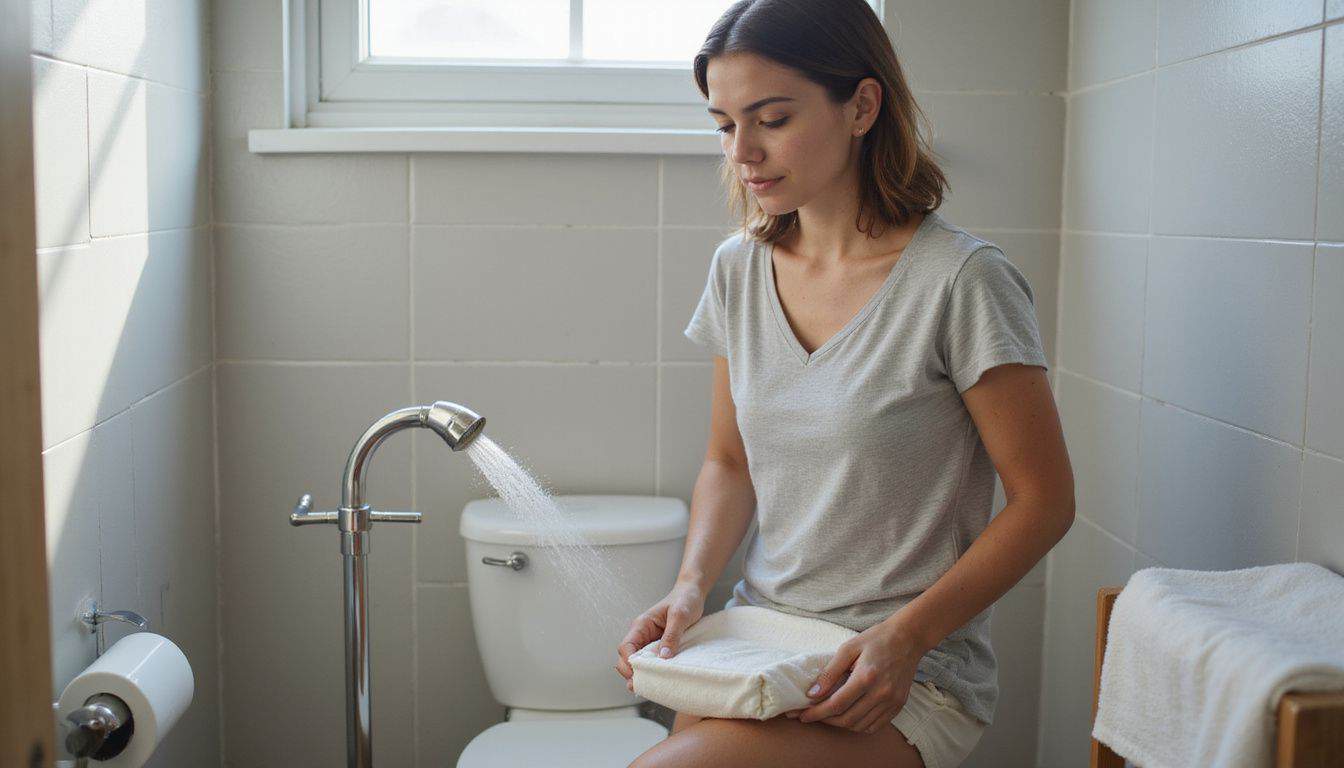
Removing poop from cloth diapers doesn’t have to be overwhelming once you know the right techniques. Each method works differently, so pick what feels most comfortable for your routine.
- Spraying works fast for quick cleanup – Hold the diaper over your toilet and use a diaper sprayer to rinse off waste effectively, making this the most popular choice for busy parents.
- Scraping removes stubborn waste completely – Use a dedicated spatula or scraper tool to lift off solid waste before tossing the diaper into your storage container.
- Shaking offers the least messy approach – This method works best for loosening waste without direct contact, though you might need follow-up cleaning for complete removal.
- Cold water helps during handwashing sessions – Rinse diapers in cold water first to prevent stains from setting, especially with formula-fed baby waste that tends to stick more.
- Toilet paper creates a barrier for easier cleanup – Place a sheet in the diaper before use, then lift and flush the waste away without touching anything directly.
- Swishing works well with water softeners – Fill a container with water and swish the diaper around to loosen waste, particularly effective in areas with hard water issues.
- Timing matters for all removal methods – Fresh waste comes off easier than dried waste, so tackle cleanup as soon as possible after diaper changes.
- Different tools work for different consistencies – Liquid waste responds better to spraying, while formed waste comes off easily with scraping or shaking techniques.
How do I wash cloth diapers properly?
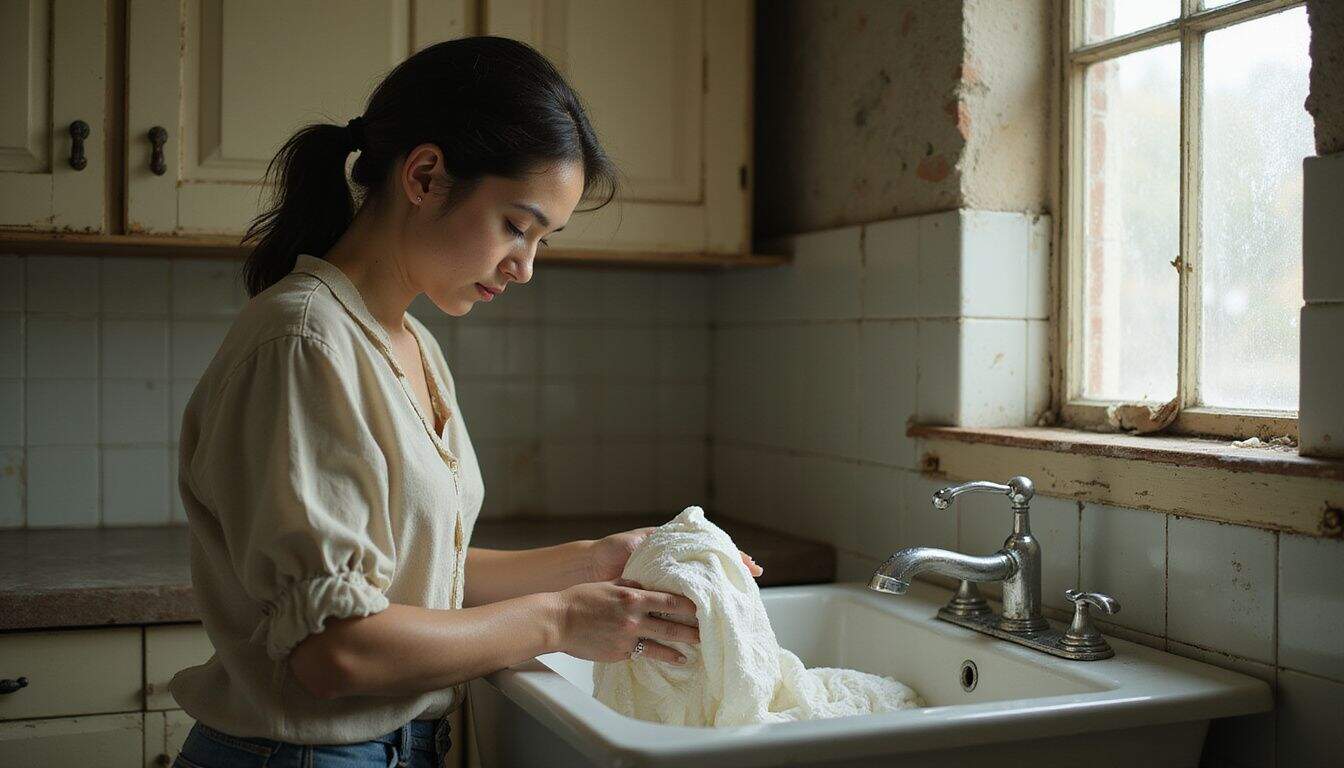
Washing cloth diapers the right way makes all the difference between fresh, clean diapers and ones that smell funky or cause rashes—and once you master the simple three-step process of rinse, wash with quality detergent, and choosing the right water temperature, you’ll wonder why you ever worried about it… but there’s so much more to discover about perfecting your wash routine, dealing with hard water issues using carbonates, and knowing when dryers can actually help your diaper care game.
Why is a rinse cycle important to remove residues?
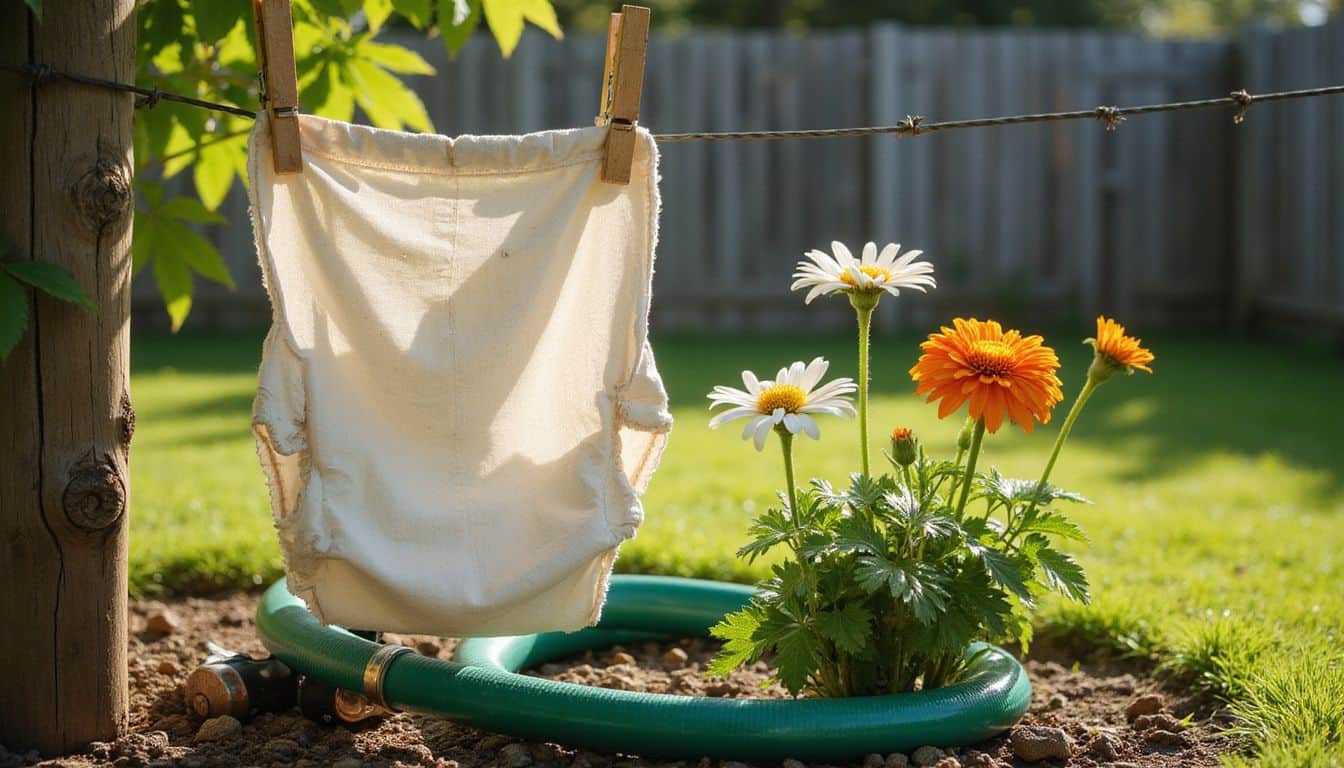
Rinse cycles eliminate detergent and waste residues that cling to cloth diaper fibers after the main wash. These leftover substances can irritate your baby’s sensitive skin, causing uncomfortable diaper rashes that nobody wants to deal with.
I learned this the hard way with my first baby, skipping extra rinses to save time, only to discover angry red patches on her bottom. Multiple rinse cycles may be necessary for heavily soiled diapers to achieve complete cleanliness, especially if you live in an area with hard water that contains high levels of carbonates.
Inadequate rinsing leaves soap buildup and waste particles trapped in the fabric, creating a breeding ground for bacteria and odors. Your washing machine’s standard cycle might not remove all traces of detergent, particularly if you use too much or have water softening issues.
Running an extra rinse ensures your diapers come out truly clean and ready for your little one’s delicate skin. The next step involves choosing the right detergent for your main wash cycle.
What detergent should I use for the main wash?
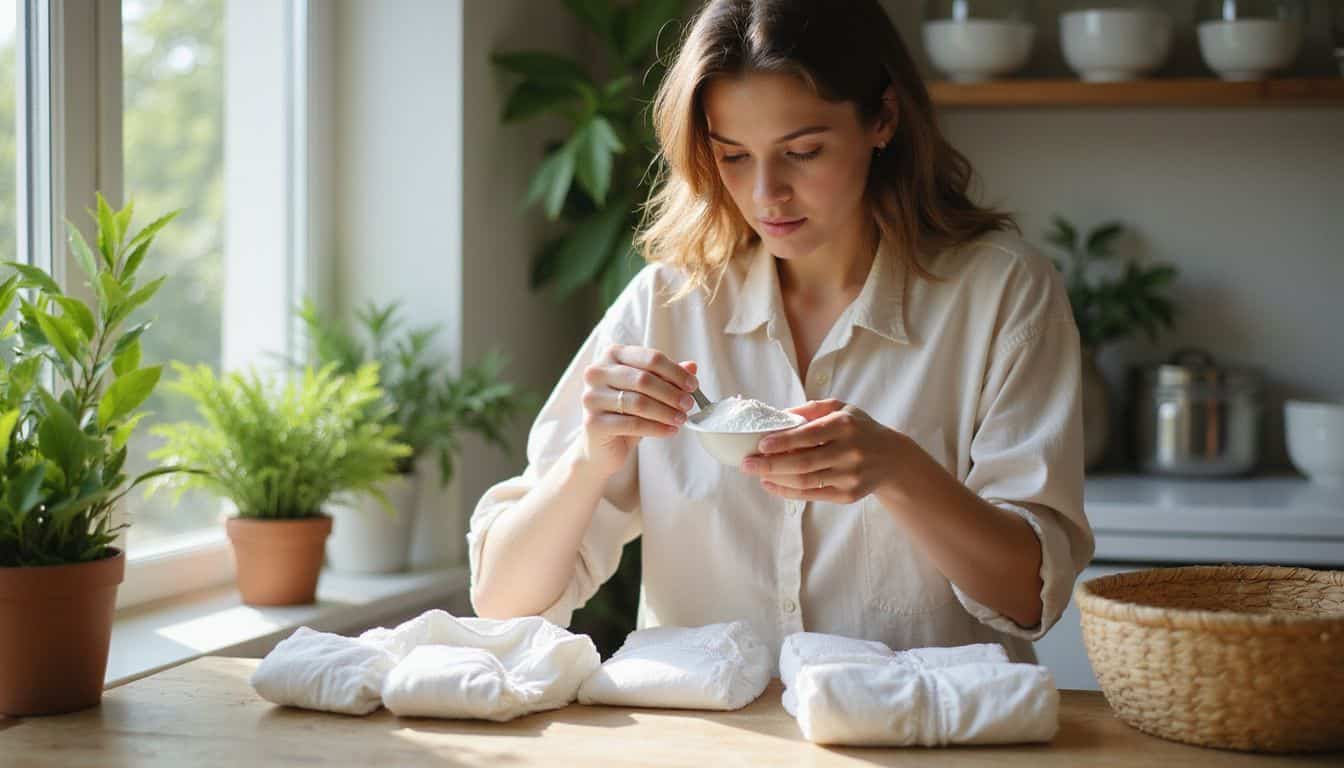
After your rinse cycle removes loose debris and waste, choosing the right detergent becomes crucial for your main wash. Fragrance-free detergents work best because they avoid allergens and ensure true cleanliness for your baby’s sensitive skin.
Detergents with enzymes effectively clean diapers by breaking down proteins and organic matter that regular soap can’t handle. Azure Clean Washing Day Powder, Country Save, BioKleen Laundry Powder, Ecos, Ecover, and Green Shield all make excellent choices for cloth diaper washing.
I’ve found that powder detergents often work better than liquid versions since they contain fewer fillers and rinse out more completely. Skip the fancy scented brands, your baby’s comfort matters more than fresh-smelling laundry.
The best detergent for cloth diapers is one that cleans thoroughly without leaving residue that can cause rashes or reduce absorbency.
What temperature is best for washing cloth diapers?
Hot water works best for washing cloth diapers after you complete a cold rinse cycle. The hottest washing cycle available on your machine kills germs and removes stubborn stains effectively.
- Start every wash routine with a cold rinse cycle to remove urine and loose debris from the fabric fibers.
- Set your washing machine to the hottest temperature setting available, typically between 140-160°F for the main wash cycle.
- Hot water breaks down proteins in bodily fluids and eliminates bacteria that cause odors and rashes on your baby’s skin.
- Cold water alone cannot dissolve oils, creams, and organic matter that build up in cloth diaper materials over time.
- Check your water heater settings to ensure it reaches at least 120°F for optimal cleaning results during wash cycles.
- Use the sanitize cycle if your washing machine offers this option, as it maintains high temperatures longer than regular hot cycles.
- Avoid warm water settings since they fall short of killing harmful microorganisms that thrive in soiled diapers.
- Test your tap water temperature with a thermometer to confirm it meets the minimum heat requirements for effective sanitization.
The next important aspect to consider is how detergent selection affects your washing results.
How can I effectively deal with stains on cloth diapers?
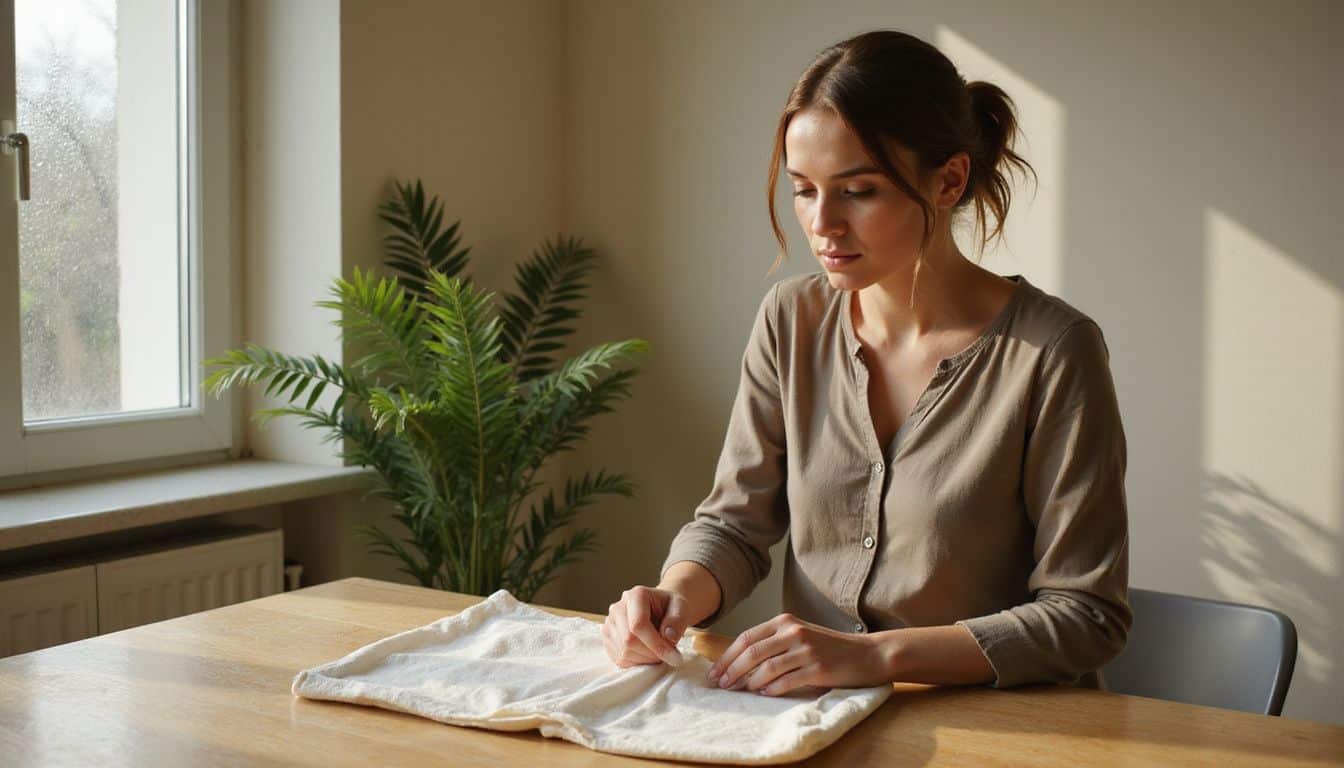
Stains on cloth diapers can feel overwhelming, but you have several effective methods to tackle them naturally and safely. The sun works as your best friend for bleaching out stubborn marks, while gentle stain removers and lemon juice offer powerful alternatives for indoor treatment.
Can sunlight help remove diaper stains?
Sunlight acts as nature’s bleaching agent, making it incredibly effective at removing stubborn stains from cloth diapers. Direct sunlight breaks down stain molecules naturally, lifting even the toughest yellow marks and discoloration that regular washing leaves behind.
A couple of hours in bright sunlight is generally sufficient for stain removal, and you’ll see dramatic results without harsh chemicals.
Applying lemon juice to damp stains enhances sunning effectiveness significantly. The citric acid works with UV rays to boost the natural bleaching process, creating a powerful stain-fighting combination.
Simply squeeze fresh lemon juice onto wet stains before placing diapers outside, then let the sun do its magic. This method works particularly well on protein-based stains and yellowing that develops over time.
How do I use lemon juice or stain removers safely?
Mix lemon juice with water to create a gentle, natural stain treatment for your cloth diapers. This citrus solution works well on yellow stains and won’t harm your baby’s skin like harsh chemicals might.
Apply the mixture directly to stained areas, then let it sit for 10-15 minutes before washing. I’ve found this method particularly effective on stubborn poop stains that regular detergent can’t tackle alone.
Test cleaning products on a small fabric area to avoid damage before treating the entire diaper. Commercial stain removers can work faster than natural options, but they need careful handling around baby items.
Choose oxygen-based bleaches over chlorine versions, since they’re gentler on fabric fibers and safer for sensitive skin. Always rinse treated diapers thoroughly after using any stain remover, whether it’s lemon juice or store-bought products, to prevent residue buildup that could irritate your little one.
What are the best ways to dry cloth diapers?
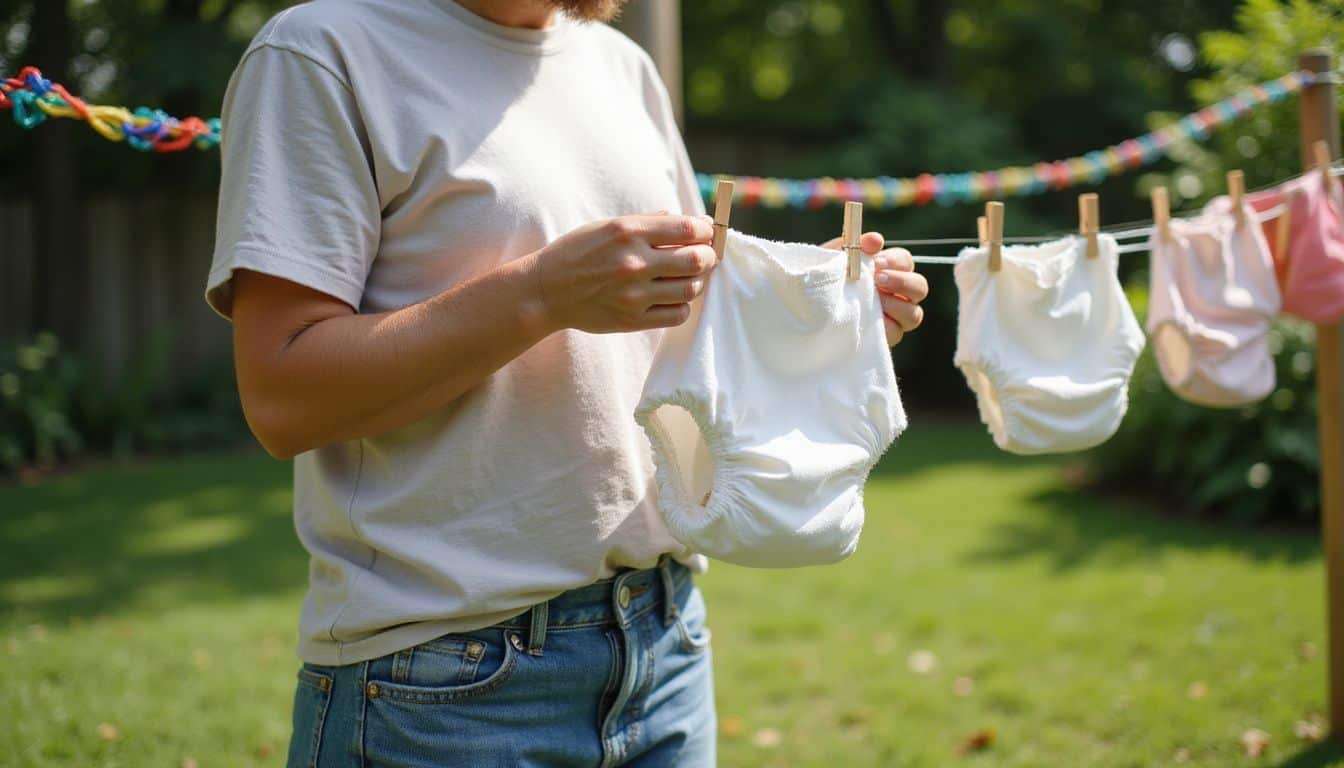
Drying cloth diapers correctly keeps them soft, fresh, and ready for your baby’s next use. You can choose between air drying outside on a clothesline or using your dryer machine, and each method offers unique benefits for maintaining your diaper stash.
How do I line dry cloth diapers properly?
Line drying cloth diapers saves money and extends their lifespan while keeping them fresh and clean. Proper air drying techniques protect the fabric fibers and maintain absorbency for years of use.
- Set up your home line or wood drying racks in a well-ventilated area with good airflow. Choose spots near windows or outdoors where air can circulate freely around each diaper.
- Space out different types of cloth diapers properly since they have varying drying times. Thick all-in-ones need more room than thin inserts, so give each piece adequate breathing space.
- Shake out each diaper before hanging to remove wrinkles and help them dry faster. This simple step prevents fabric from clumping together and speeds up the drying process.
- Hang diapers by the tabs or waistband rather than the absorbent areas. This method prevents stretching the most important parts and maintains the diaper’s shape over time.
- Turn pocket diapers inside out so the inner fabric gets direct airflow. The absorbent side dries slower, so flipping them helps moisture escape more quickly.
- Rotate diapers halfway through drying time to ensure even moisture removal. Check them after a few hours and flip them around for complete drying.
- Bring diapers inside if rain threatens or humidity levels rise too high. Damp weather can cause mildew and actually slow down the drying process significantly.
- Test for complete dryness by feeling the thickest parts before storing them away. Damp spots can lead to odor problems and reduce the diaper’s effectiveness during use.
Can I use a dryer safely for cloth diapers?
Air drying works great, but busy moms often need faster solutions. Machine drying offers convenience without damaging your cloth diapers if done correctly.
- Check your diaper manufacturer’s care instructions first, as some brands handle heat better than others and specific guidelines prevent warranty issues.
- Use low or medium heat settings exclusively to prevent heat stress and extend your diapers’ lifespan, avoiding high temperatures that can damage elastic and waterproof materials.
- Remove diapers while slightly damp to prevent over-drying, which makes fabrics stiff and can cause premature wear on seams and closures.
- Skip fabric softener sheets completely since they create buildup that reduces absorbency and can irritate your baby’s sensitive skin during diaper changes.
- Dry covers and inserts separately when possible, as waterproof covers need gentler treatment than absorbent cotton or hemp inserts that handle heat better.
- Clean your dryer’s lint trap before each load to maintain proper airflow and prevent overheating that could damage synthetic materials in modern cloth diapers.
- Add wool dryer balls to reduce drying time naturally and keep fabrics soft without chemicals that interfere with diaper performance or cause rashes.
- Stop the cycle early if you smell burning or notice excessive heat, as overheated elastic loses stretch and waterproof layers can delaminate permanently.
When and how should I strip cloth diapers?
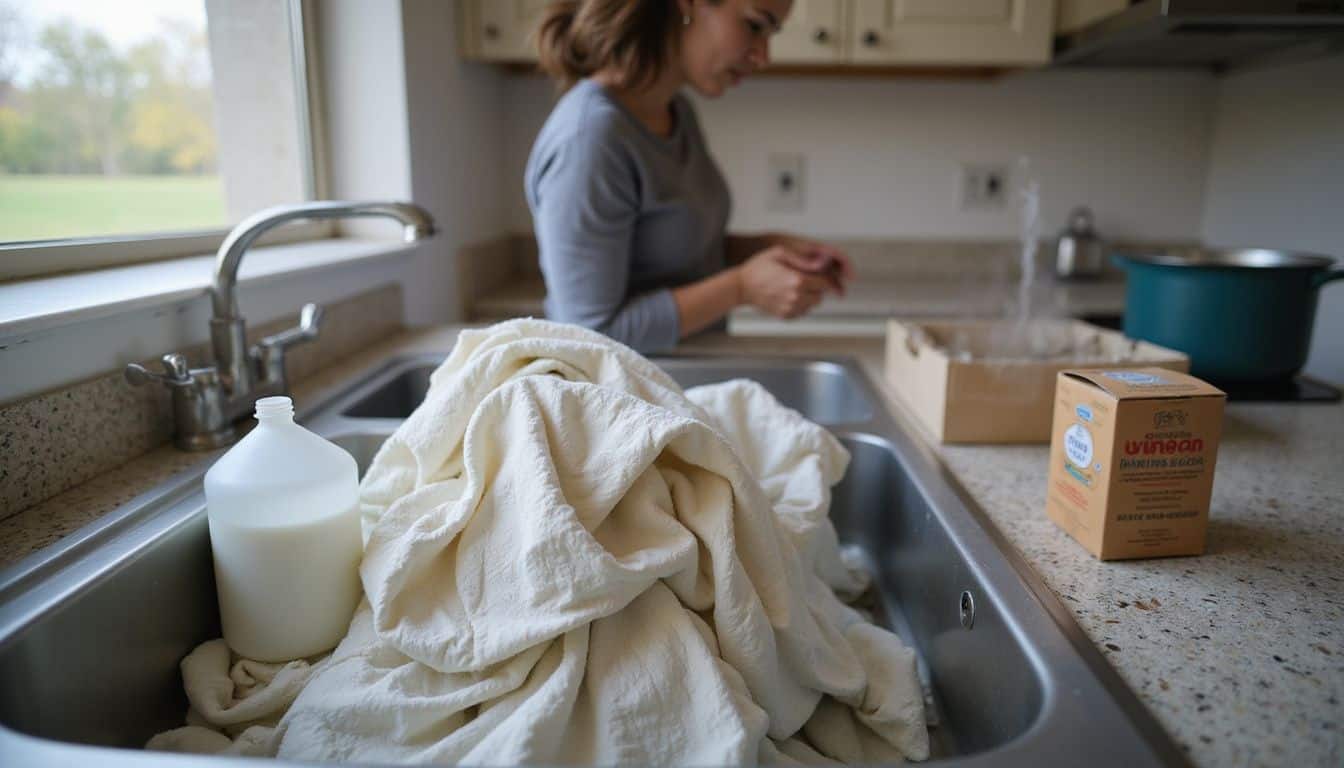
Sometimes cloth diapers build up detergent, minerals, or oils that regular washing can’t remove… and that’s where stripping comes in. You’ll know it’s time to strip when your clean diapers smell funky, repel water, or cause rashes on your baby’s skin.
How do I know when it’s time to strip diapers?
Cloth diapers need deep cleaning when regular washing stops working properly. Eight clear signs tell you it’s time to strip your diapers and restore their performance.
- Your diapers smell funky even after washing them with your usual detergent and hot water cycle.
- Absorbency drops noticeably, and diapers leak more often during normal wear periods.
- Stains stick around despite using your regular stain removal methods and sun drying.
- Ammonia smell hits you when you open a fresh diaper or during diaper changes.
- Rashes appear on your baby’s skin more frequently, even with proper changing routines.
- Diapers feel stiff or rough against your baby’s skin instead of soft and flexible.
- Water beads up on the diaper surface instead of soaking in quickly during absorbency tests.
- Soap buildup creates a slippery or waxy feeling on the fabric surface when you touch it.
What methods work best for stripping cloth diapers?
Stripping cloth diapers removes stubborn buildup that regular washing can’t handle. You’ll need specific methods to tackle ammonia, bacteria, and severe residue problems.
- Create the basic stripping solution – Mix three tablespoons each of Washing Soda, Borax, and Calgon in hot water. This powerful combination breaks down mineral deposits and soap residue that cling to diaper fibers.
- Soak diapers for four to six hours – Submerge clean diapers completely in your stripping solution. The extended soaking time allows the ingredients to penetrate deep into fabric layers and dissolve stubborn buildup.
- Use the bathtub method for large loads – Fill your bathtub with hot water and add the stripping solution. This gives you more space to agitate diapers by hand and ensures even distribution of the cleaning mixture.
- Try the washing machine soak cycle – Set your washer to the highest water level with hot water. Add the stripping solution and let diapers soak without agitation for the recommended time period.
- Apply the RLR method for mineral buildup – Use RLR (Remove, Lift, Rinse) powder following package directions. This commercial product targets hard water minerals that cause gray, dingy diapers and absorption issues.
- Test the dishwasher tablet technique – Drop one original Cascade tablet into a hot wash cycle with clean diapers. The enzymes break down protein stains and soap scum effectively.
- Perform multiple rinse cycles after stripping – Run at least three rinse cycles to remove all stripping solution residue. Any leftover chemicals can irritate baby’s skin and reduce diaper absorbency.
- Check for ammonia smell during the process – Properly stripped diapers should smell neutral when wet. Strong ammonia odors indicate you need to repeat the stripping process or try a different method.
How can I maintain cloth diapers for long-term use?
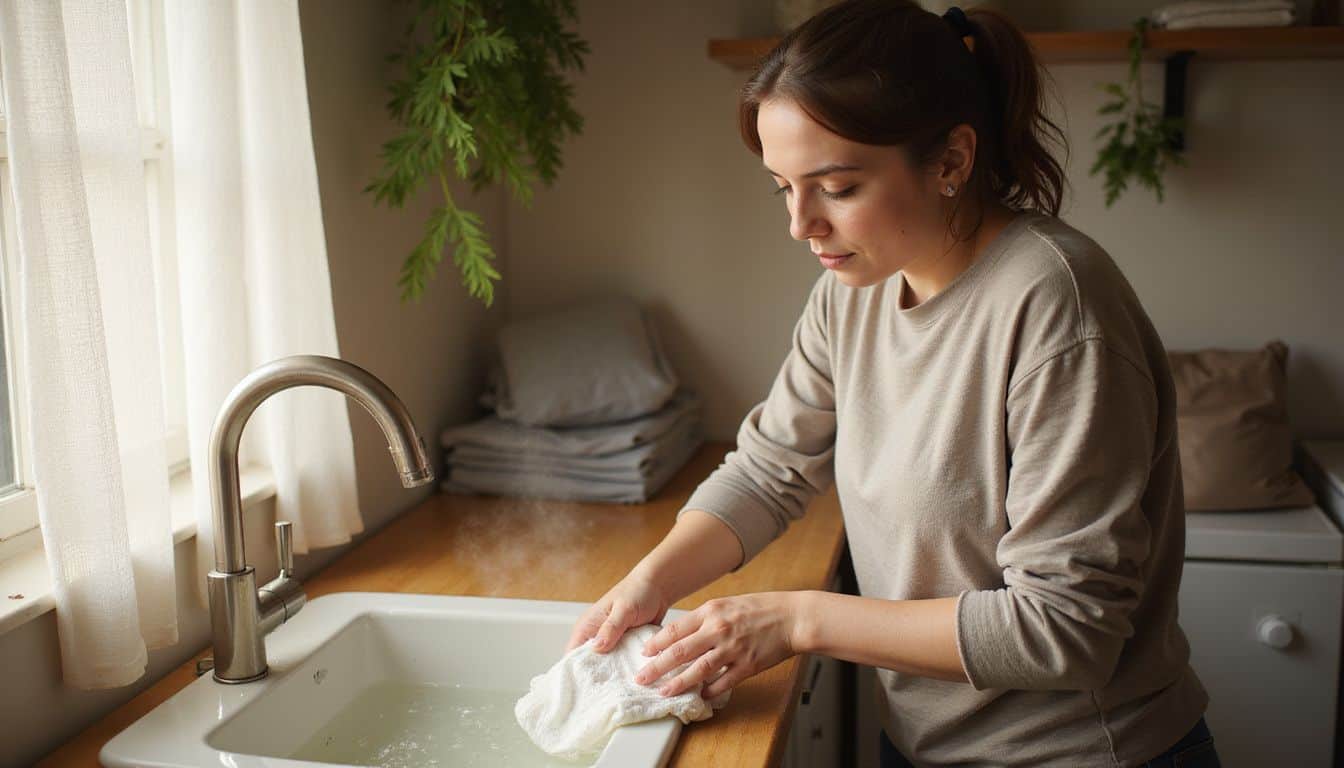
Taking care of your cloth diapers the right way helps them last for years, saving you money and keeping them working well. Simple daily habits and smart choices protect your investment… making sure your diapers stay soft, absorbent, and ready for whatever your little one throws at them.
Why should I avoid fabric softeners with cloth diapers?
Fabric softeners coat fabrics with a waxy layer that blocks absorption. This coating makes your cloth diapers less effective at soaking up moisture, which defeats the whole purpose of using them.
Your baby’s diaper will feel wet longer, and you might notice leaks happening more often than usual.
Skip the fabric softener completely to keep your diapers working their best. The coating from these products builds up over time, making your diapers feel soft but useless for their main job.
Fabric softeners diminish the absorbency of cloth diapers, so stick to regular detergent for washing. Your diapers will stay absorbent and do what they’re supposed to do, keeping your little one dry and comfortable.
How often should I clean my washing machine?
Your washing machine needs a deep clean once every month to keep cloth diapers truly fresh and odor-free. Dirty diapers leave behind bacteria, soap buildup, and mineral deposits that can make your machine smell funky… and nobody wants that stinky surprise when doing regular laundry! I learned this the hard way after my machine started leaving a musty smell on everything, including my baby’s freshly washed clothes.
Monthly deep cleaning prevents soap scum from building up in the drum and hoses, which can trap odors and reduce your machine’s cleaning power. Run an empty hot water cycle with two cups of white vinegar, followed by another cycle with baking soda to neutralize any remaining residue.
Front-loading machines especially need this regular maintenance since they’re more prone to mold growth around the rubber seals. Clean those seals with a damp cloth after each diaper wash, and leave the door open to air dry between loads.
Now that your machine is sparkling clean, let’s look at what the future holds for cloth diaper care routines.
How Will Cloth Diaper Care Evolve in 2025?
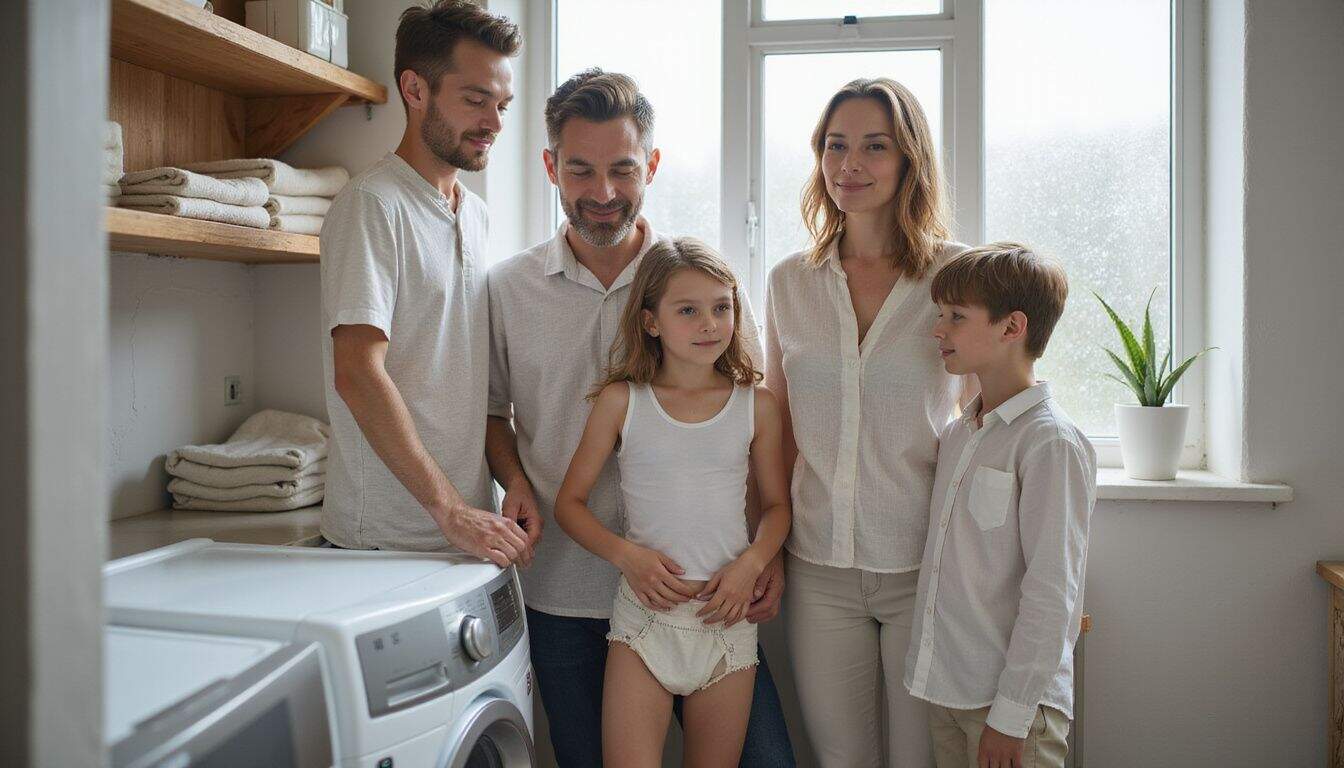
Cloth diaper care will undergo significant changes in 2025, with washing machines specifically created for cloth diaper cleaning and hygiene entering the market. These specialized appliances will simplify and improve the washing process for busy moms.
Eco-friendly detergents formulated for effective cloth diaper care will become increasingly popular as parents aim to reduce landfill waste from disposables. Improved materials for cloth diapers will provide better absorbency and stain resistance, simplifying daily care.
Storage solutions will significantly improve with innovations in wet bags that offer enhanced odor control and convenience. The cloth diapering community will strengthen, offering more online resources and support for new parents learning the process.
Parents interested in exploring different aspects of diaper care can learn more about diaper punishment methods.
These advancements will make cloth diapering more accessible and practical for families who want to decrease their environmental impact while saving money.
People Also Ask
How often should I wash cloth diapers?
Wash dirty cloth diapers every 2-3 days to prevent stains and odors from setting in. Storing soiled diapers longer can make cleaning much harder.
What’s the best way to remove poop from cloth diapers?
Rinse solid waste into the toilet first, then do a cold rinse cycle before your main wash. For breastfed baby waste, you can skip the rinse since it dissolves easily in water.
Can I use regular detergent on cloth diapers?
Yes, most standard detergents work well for cloth diapers. Avoid fabric softeners and bleach, as these can damage the absorbent fibers and reduce effectiveness over time.
How do I dry cloth diapers properly?
Line drying in sunlight naturally bleaches stains and kills germs. You can also use a dryer on medium heat, but air drying helps your diapers last longer and saves energy costs.
References
https://www.thinking-about-cloth-diapers.com/preparing-new-cloth-diapers.html
https://www.greenandhappymom.com/post/prepping-cloth-diapers (2023-01-20)
https://www.healthline.com/health/how-to-wash-cloth-diapers (2020-03-28)
https://simplebeingdiapers.com/blogs/news/the-no-sh-t-guide-to-cloth-diapers-and-poop (2021-10-28)
https://www.dreft.com/en-us/washing-tips/washing-baby-clothes/how-to-wash-cloth-diapers
https://www.allaboutclothdiapers.com/how-should-you-dry-your-diapers/
https://www.mamanatural.com/when-to-strip-cloth-diapers/
https://jilliansdrawers.com/pages/washing-cloth-diapers
https://www.allaboutclothdiapers.com/umm-yes-you-should-clean-your-washing-machine-ill-show-you-how/
